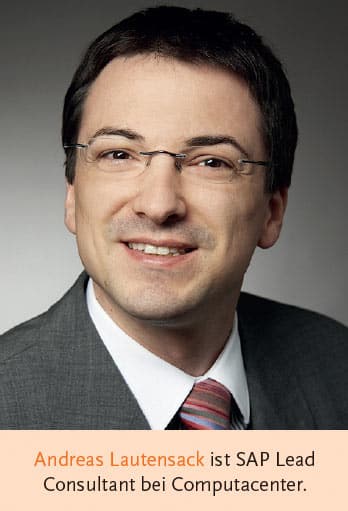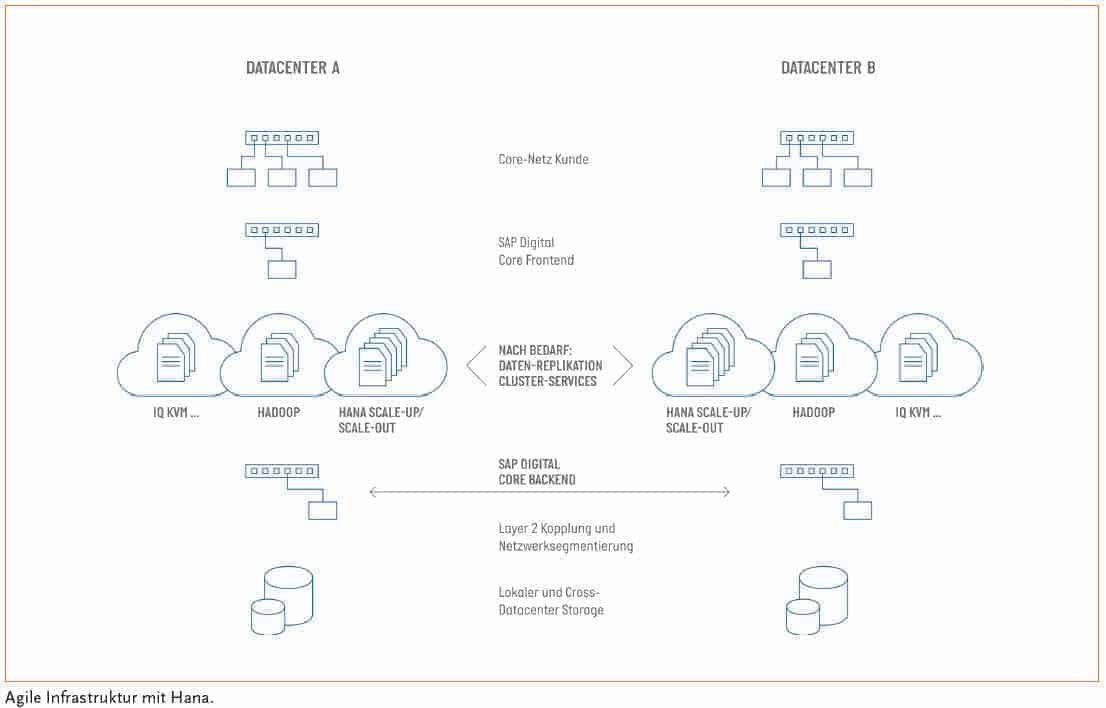Opportunity constraint
![[shutterstock.com:237333028, lassedesignen]](https://e3mag.com/wp-content/uploads/2016/06/shutterstock_237333028.jpg)

According to a study by Techconsult in December 2015, 60 percent of all companies have already looked into S/4 Hana. In doing so, they hope to ensure success with regard to the digital transformation.
SAP promises significant performance improvements with Hana compared to classic databases. A look at the IT infrastructure offers further opportunities to increase efficiency and reduce costs - but only if you get it right from the start.
After all, if companies are going to switch to Hana, it is best to do so efficiently and in a future-proof manner. Therefore, the entire infrastructure should be put to the test and made cloud-capable.
Anyone who thinks outside the box recognizes the great potential that S/4 brings with it. Especially when companies see the renewal of their infrastructure as an opportunity to take a big step towards the hybrid cloud.
Non trivial
 However, modernizing the entire IT infrastructure is a very extensive undertaking that companies need to plan with great foresight. They should not simply address existing problems, but fix the root causes.
However, modernizing the entire IT infrastructure is a very extensive undertaking that companies need to plan with great foresight. They should not simply address existing problems, but fix the root causes.
Anyone who wants to use S/4 in the future must first migrate their SAP Business Suite to Hana before the functional innovations of S/4 can be integrated in the next step. This means that S/4 can be deployed in small steps.
Therefore, it first makes sense to comprehensively plan what the architecture for the entire SAP landscape should look like.
Subsequently, operating processes must be optimized and systems consolidated - even if the target architecture may not be achieved for three or four years.
Companies should always keep an eye on the big picture and not start hastily with a single system in focus. After all, the changeover offers the opportunity to reassess all elements of the IT infrastructure.
As-is analysis at the beginning
Before switching to Hana, a comprehensive as-is analysis of the SAP landscape, the operating processes and the IT architecture should be carried out. The first step is a detailed technology comparison in which the current inventory of all infrastructure components - from storage to servers to virtualization technology - and the current database are analyzed.
In addition, operating processes are examined in detail and it is worked out what will change with regard to the establishment of a new architecture. In the process, companies should be able to identify the potential savings.
Companies should keep an eye on the entire SAP landscape right from the start and not limit themselves to just one system because, for example, only the SAP Business Warehouse is to be migrated to Hana in a first step or S/4 Finance is being introduced.
Companies think too narrowly here, they leave scaling opportunities unused and do not exploit the full savings potential.
While it is certainly possible to start with smaller entry scenarios and move step by step toward a "big" target architecture, if this target picture is not known, companies are blocking opportunities that Hana can offer.
Target architecture and roadmap
Based on the as-is analysis, a promising target architecture is developed, including the required parts lists of the individual components that are needed.
At the same time, Computacenter defines so-called Building Blocks, which companies can use to gradually start building their startup configuration.
The important thing here is to develop a modular, scalable target architecture. From this target architecture, individual modules can then be built for the systems that are to be converted to Hana in the first step, which are then supplemented with each new system.
Companies also receive a cost overview that includes implementation and migration efforts in addition to the costs for the infrastructure. The implementation roadmap also shows how long the process will realistically take.
What the optimal infrastructure looks like in the end is highly individual and depends on the customer's requirements. This can range from small virtualized individual systems to large cluster systems with dozens of servers in an SAP installation.
The target architecture must be designed to be able to respond quickly to new requirements without changes to the design. However, a prerequisite for the systems used, such as servers and storage, is that they are certified by SAP; only then can they be used productively for Hana.
With Hana into the Cloud
In order to prepare for S/4 Hana and the new possibilities, companies must also ask themselves which data should go to the cloud. Because many companies do not want to outsource their critical SAP data to the cloud.
At the same time, however, more and more organizations are realizing that certain data and systems do not necessarily have to be operated in their own data center.
On-premise systems offer the advantage that data is stored and processed in the company's own data center. The disadvantage is that companies need their own infrastructure and thus often lack the flexibility to react quickly to new requirements.
By using cloud services, they are able to meet these new requirements more quickly. That's why more and more companies are turning to hybrid cloud solutions and enjoying the benefits of both worlds: The company's own data center is converted into a private cloud and delivers the usual security.
External cloud services such as Amazon Web Services or Virtustream complement SAP's public cloud services.
The integration of external cloud services is proving particularly useful at a time when the number of new requirements from the business departments is constantly increasing and IT is being forced to react flexibly and quickly. This is because the "big" cloud providers have completely different options in terms of scaling, which ultimately results in an economic advantage for users.
In addition, departments in companies are keen to purchase services that meet their individual requirements and can also be billed according to consumption.
An example of such a hybrid cloud architecture can be development and test systems. These are often not used at their full capacity. However, if companies operate them in their own data center, they are designed for peak load.
If a company uses these systems as a cloud service, it only has to pay for the resources that are actually used. The productive system can thus continue to run in the company's own secure data center.
Automated operating processes
Companies can save a lot of costs during deployment: This is because there are now tools that can be used to automate the operational processes - from provisioning to installation and configuration of the Hana database. Since such deployment processes occur very often in a company, optimization is worthwhile.
With its cloud management platform (CMP) offerings, Computacenter thus enables automated deployment that ensures adherence to the time horizon and also plays a key role in the development of hybrid cloud solutions.
In addition to automating the deployment processes, integration into existing orchestration solutions can take place and the provision of SAP systems can be realized via self-service portals. In the future, it should no longer matter whether the physical deployment takes place in the company's own data center or at a public cloud provider.
Due to the necessity of having to react more and more quickly to increasing requirements from the business departments in the future, complete automation of the operating processes should be considered at the same time as automated deployment of the operating system and database.
This includes changes to the operating system as well as adjustments to the database and SAP software such as updates, parameterization or system copies. Manual standard tasks are avoided, thus increasing quality and traceability and relieving employees.
Memory requirements and performance
If companies consistently follow the path towards a modern IT infrastructure, they can enjoy a uniform, comprehensive, consolidated and standardized software platform where the maintenance and innovation intervals of the individual components can be coordinated.
This significantly simplifies the operation of the SAP landscape. In addition, there is now only one system, with one database and data basis, which all applications access. This means that data center costs can be reduced, as less storage is required and operating costs are lowered.
Customer examples show that the migration from classic databases to Hana leads to a reduction in data volume of around 30 percent. If a company had a volume of ten terabytes before, it is only three terabytes after the migration.
In addition, the requirements for the storage systems change in a Hana architecture, as they no longer need to perform as well in normal operation. Since all data is stored in the main memory, storage costs can be halved, although server costs increase slightly.
Hana - without additional costs
All this means that the new platform can be used without additional costs during ongoing operations if the entire system landscape is migrated. SAP customers do have to purchase new licenses and there are also costs for the actual migration.
But these investments play a rather minor role compared to the significant cost savings in business processes, operations and increased revenue from new business scenarios.
Conclusion
By switching to Hana, companies can take the first step toward using S/4, which must be completed by 2025. Because then the old SAP Business Suite will no longer be supported.
Companies should see this move as an opportunity to restructure their entire IT infrastructure and make it cloud-enabled.
Although the implementation is costly, the result is an operation that is optimized from the ground up and fit for the future. This is because companies are significantly more flexible and able to meet current and future requirements more quickly.
If you also rely on automated deployment of Hana infrastructures, you can save a lot of effort. The important thing is to always keep the big picture in mind, not to fixate too quickly on one system or problem, and to think through the implementation step by step.





